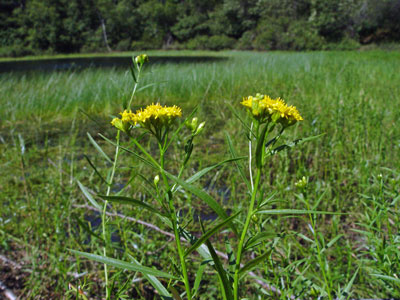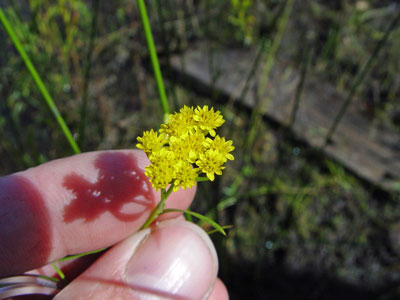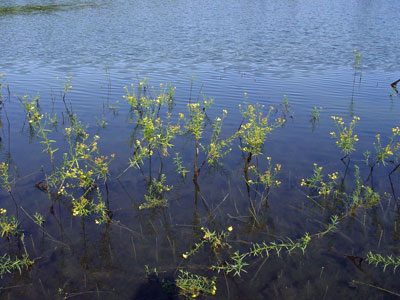DACF Home → Bureaus & Programs → Maine Natural Areas Program → Communities, Plants, and Animals → Rare Plants → Euthamia caroliniana

Euthamia caroliniana (L.) Greene ex Porter & Britt.
Narrow-leaved Goldenrod
- State Rank: S2
- Global Rank: G5
- State Status: Threatened
Habitat: Outwash plain pondshores, in moist sand, usually below seasonal high-water level. [Open wetland, not coastal nor rivershore (non-forested, wetland)]
Range: Coastal, from Nova Scotia south to Virginia.
Aids to Identification: This goldenrod bears flat-topped flower clusters and grows to 0.3-1 m. The flat-topped inflorescence have flowering heads have 17-21 flowers, of which 10-16 are ray flowers. The leaves are very thin, only 2-3 mm wide, with one central nerve and usually a pair of weak lateral nerves. A similar but very common goldenrod species, E. graminifolia, can be distinguished by its 3-nerved leaves with additional faint lateral nerves, and capitula with 20-35 flowers (of which 15-25 are ray flowers).

Ecological characteristics: Where the habitat is intact and of good quality, Euthamia caroliniana may be the dominant herb.
Phenology: Flowers August - October.
Family: Asteraceae
Synonyms: Euthamia galetorum Greene; Euthamia microcephala Greene; Euthamia microphylla Greene; Euthamia remota Greene; Euthamia tenuifolia (Pursh) Nutt.; Solidago tenuifolia Pursh.; Solidago tenuifolia Pursh. var. pycnocephala Fern.
Known Distribution in Maine: This rare plant has been documented from a total of 6 town(s) in the following county(ies): Cumberland, Oxford, York.

Reason(s) for rarity: At northern limit of range.
Conservation considerations: Heavy all-terrain vehicle use of the sandy habitats where this occurs has degraded the habitat in some locations and continued use will be detrimental to the plant populations.